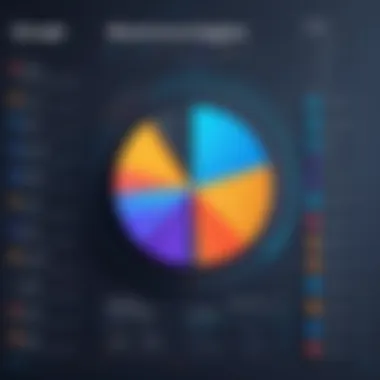Comparative Analysis of Bannerflow and Rivals


Intro
In the digital marketing world, banner advertising holds significant importance. Bannerflow has emerged as a prominent player in this field. Businesses seek effective solutions to create engaging advertisements efficiently. However, understanding the competitive landscape around Bannerflow can reveal valuable insights. Knowing the strengths, weaknesses, and pricing of competitors is crucial for making informed decisions. This analysis will illuminate the alternatives available in the banner advertising market, helping businesses discern which platforms may suit their needs the best.
Overview of Software
Purpose and Use Cases
Bannerflow's purpose revolves around facilitating businesses in designing and managing online advertisements. It offers tools that cater to various marketing needs, whether for brand promotion, product launches, or event announcements. Advertisers can create dynamic and responsive banners that appeal to diverse audiences across multiple platforms.
Key use cases include:
- E-commerce campaigns for product showcasing.
- Event promotion to generate interest and attendance.
- Brand awareness efforts aimed at increasing visibility.
- Retargeting ads that remind previous visitors about products or services.
Key Features
Bannerflow boasts several features that distinguish it from its competitors. These features address the core needs of users while enhancing the overall advertising experience. Notable features include:
- Drag-and-drop interface enabling easy ad creation for users with varying levels of technical skills.
- A/B testing capabilities to optimize ads based on performance metrics.
- Integration with multiple ad networks, enhancing reach and efficiency.
- Dynamic content generation, allowing advertisers to tailor messages based on user data or behavior.
"Understanding the competitive landscape ensures businesses select the best tools tailored to their unique advertising needs."
In-Depth Review
Performance Analysis
In assessing the performance of Bannerflow competitors, it becomes clear that factors such as speed and reliability are paramount. Competitors may offer varying load times and performance metrics. For instance, some platforms might excel in quick ad delivery, while others might lag, affecting user engagement. Additionally, the resources required for execution can vary significantly across each competitor's platform, ranging from cloud-based solutions to local installations.
User Interface and Experience
The user interface (UI) is crucial when evaluating competing software. A well-designed UI can facilitate user experience (UX), leading to higher satisfaction and productivity. Bannerflow provides a clean and intuitive interface, yet competitors might present different styles. Users often favor platforms with visually appealing layouts and streamlined navigation. Some competitors employ intricate designs that may overwhelm users, while others prioritize simplicity, enhancing usability.
Considerations when analyzing usability include:
- Ease of navigation across different functionalities.
- Customization options that allow users to tailor the UI according to personal preferences.
- Support resources, such as tutorials, that can help users understand features quickly.
This detailed analysis of the competitive banner advertising software landscape will offer valuable insights through subsequent sections.
Prelude to Bannerflow
In the contemporary landscape of digital marketing, understanding how different platforms facilitate banner advertising is crucial. Bannerflow is a prominent player, providing tools for creating and managing digital advertising banners. An analysis of Bannerflow offers insights into its operational strengths and reveals how it stacks up against its competitors in the market. Such understanding is vital for businesses aiming to optimize their ad strategies and maximize engagement.
Overview of Bannerflow
Bannerflow allows users to design, edit, and publish banners across various channels from a single platform. The system is accessible and designed for both marketers and designers, featuring an intuitive interface. Bannerflow integrates with various advertising networks, which streamlines the process of deploying ads. Its name is increasingly recognized among marketing professionals who seek efficiency and creativity in their online campaigns.
Core Features of Bannerflow
Bannerflow presents several core features that distinguish it from its competitors:
- Template Variety: Users have access to numerous templates, which cater to different brand identities and campaign needs. Customization options enhance creative flexibility.
- Collaboration Tools: The platform supports real-time collaboration among team members. This is essential in facilitating rapid feedback loops and approving designs more efficiently.
- Analytics and Reporting: Advanced analytics tools provide insights into how ads perform. This data is critical for making informed adjustments to campaigns.
- Integrated Asset Management: Users can manage all digital assets directly within the platform. This reduces the time spent searching for assets in various locations.
- Responsive Design Capabilities: Banners created can automatically adapt to different sizes and formats, ensuring a consistent look across devices.
These features not only enhance user experience but also contribute to increased campaign effectiveness. Businesses using Bannerflow can enjoy streamlined workflows that save time and enhance outcomes.


The Competitive Landscape
Understanding the competitive landscape around Bannerflow provides valuable insights into the dynamics of the online banner advertising market. It is crucial as competitors continuously evolve their offerings, adapting strategies in response to user demands and technological advancements. By observing these competitor actions, stakeholders can make informed decisions regarding advertising solutions.
The landscape is not simply about identifying who the players are; it involves examining their market positions, unique value propositions, and how they differentiate themselves. Analyzing the strategies of competitors allows businesses not only to benchmark against established standards but also to find opportunities for improvement and innovation.
Additionally, exploring competitive factors sheds light on industry trends that could impact Bannerflow and its rivals. For instance, shifts in consumer preferences toward personalized advertising can force all players to reassess their approaches. This section will discuss the underlying aspects that shape competition in this space.
Understanding Market Competition
Market competition refers to the rivalry among businesses selling similar products or services. In the context of online banner advertising, it involves companies striving to attract clients by offering superior tools and services. The presence of several strong competitors, such as Google Web Designer and Adobe Creative Cloud, creates a vibrant ecosystem, compelling each player to continuously improve.
The motivations behind these competitive actions include increasing market share, enhancing customer satisfaction, and diversifying the product lineup. Companies leverage various tactics such as aggressive pricing, innovative features, or exceptional customer support to establish an edge. A profound understanding of competitors allows Bannerflow and others to recognize not only threats but also potential collaborative opportunities.
Key Factors Influencing Competitiveness
Several factors significantly influence the competitive landscape in the banner advertising sector:
- Quality of Features: The ability of software to meet user demands sets apart different solutions. Bannerflow must compete against tools that offer robust design functionalities.
- Pricing Strategies: Price can be a determining factor for clientele. High-quality tools must balance affordability with the value they provide.
- Customer Support and Community Engagement: Responsive customer support can enhance user experience and brand loyalty. Engaging with users through forums or social media can be a differentiator.
- Technological Innovation: As technology evolves, so do user expectations. Companies that invest heavily in R&D often lead in providing cutting-edge solutions.
- User Experience and Accessibility: The ease with which users can navigate and utilize software impacts retention rates. A straightforward interface can attract users new to banner designing.
Top Competitors of Bannerflow
The examination of the top competitors of Bannerflow is crucial to understanding the broader market dynamics in the online banner advertising sector. As businesses navigate their marketing strategies, identifying viable alternatives to Bannerflow can provide insights into different approaches, pricing models, and unique features that may better suit specific needs. This section focuses on five prominent competitors, namely Google Web Designer, Adobe Creative Cloud, Canva, Bannersnack, and Visme. Each of these platforms has distinct characteristics that impact usability, pricing, and overall effectiveness in delivering advertising solutions. By breaking down these competitors, we aim to give readers a clearer view of how they contrast with Bannerflow and what unique advantages they each bring.
Competitor One: Google Web Designer
Overview and Features
Google Web Designer is a key tool for creating responsive HTML5 content. Its primary strength lies in its seamless integration with other Google products and services, which enhances campaign efficiency. The user interface is visually oriented, making it accessible for users without deep coding knowledge. Google Web Designer allows advanced features like animation and 3D effects, setting it apart in the landscape of design tools.
Pricing Structure
Google Web Designer is available free of charge. This aspect attracts many users, especially small businesses with limited budgets. However, while the lack of a pricing model may seem advantageous, the absence of extensive customer support could be a downside for users needing assistance during their projects.
Strengths and Weaknesses
A major strength of Google Web Designer is its compatibility with Google Ads. This provides a streamlined experience for users who run campaigns through Google platforms. The downside, however, is that it may not be as intuitive for users who prefer a more guided approach, as some aspects can be complex for beginners without prior design experience.
Competitor Two: Adobe Creative Cloud
Product Range
Adobe Creative Cloud offers a comprehensive suite of tools including Photoshop, Illustrator, and InDesign. This extensive product range caters to diverse creative needs, providing capabilities that go beyond banner creation. The versatility makes it a favored option for professionals who require high-quality visuals across various mediums.
Usability Aspects
Despite its powerful features, Adobe Creative Cloud has a somewhat steep learning curve. Users often find the tools overwhelming at first. However, once familiarized, they can take advantage of advanced editing functionalities. The option to integrate various Adobe applications adds significant value for users seeking a cohesive design workflow.
Market Positioning
Adobe dominates the market due to its reputation and range of trusted products. This positioning makes it a strong competitor against Bannerflow. Users often prefer established brands for their reliability and comprehensive resources, even if Adobe's pricing is on the higher side.
Competitor Three: Canva
User Experience


Canva stands out for its user-friendly interface. Designed for individuals with little to no design experience, it simplifies the creation process with pre-made templates and drag-and-drop features. This approach is appealing for small businesses looking to produce attractive banners quickly.
Cost-Effectiveness
Canva operates on a freemium model, which means users can access basic features for free but must pay for advanced functionalities. This pricing structure can be advantageous for users who need limited features, while those seeking more advanced tools will find the premium tier affordable.
Integration Capabilities
Canva offers integration with various social media platforms, enhancing its utility for users engaged in digital marketing. However, its reliance on internet connectivity can be a limitation for users in areas with unstable access, potentially impacting usability.
Competitor Four: Bannersnack
Feature Analysis
Bannersnack focuses specifically on banner creation, offering unique features like GIF support and HTML5 animations. This specialization gives it an edge in developing visually engaging banners, which can lead to higher engagement rates. However, this specialization may limit its broader design capabilities compared to competitors with multifunctional platforms.
Target Audience
Bannersnack primarily targets professionals and businesses that require quick and appealing banner solutions. This targeting means it excels in meeting the needs of digital marketers, although it might not cater to a wider audience of graphic designers seeking extensive creative options.
Service Limitations
One of the limitations of Bannersnack is its limited customer support compared to larger competitors. Users seeking hands-on assistance might find this a drawback, especially when navigating more complex projects.
Competitor Five: Visme
Capabilities Overview
Visme offers a robust platform for creating infographics and presentations alongside banners. This range makes it suitable for users looking for versatile design capabilities. Its emphasis on data visualization can be particularly advantageous for businesses focusing on analytics-driven marketing.
Educational Use Case
Visme is also popular in the education sector for creating engaging learning materials. This unique use case enhances its value proposition, as educational institutions often seek tools to produce visually appealing and informative resources.
Customer Satisfaction
User feedback on Visme highlights its intuitive interface and effective customer support. However, some customers express concerns over the pricing, particularly in relation to available features compared to other free or lower-cost options.
Overall, understanding these competitors provides valuable insights into alternatives to Bannerflow. Each option has its strengths and weaknesses, making it essential for users to assess their specific needs before choosing a platform.
Comparative Analysis
Comparative analysis plays a crucial role in understanding a product's competitive positioning in the market. In this case, the focus is on Bannerflow and its main competitors. By analyzing the features, pricing, and user feedback of these competing platforms, businesses can make informed choices about which tool best aligns with their marketing needs and objectives.
This analytical approach benefits organizations by highlighting not only what each platform excels at but also pinpointing their limitations. This dual focus allows companies to weigh the pros and cons effectively and evaluate how well a solution fits into their overarching strategies.
Feature-by-Feature Comparison
A feature-by-feature comparison is essential for understanding how each competitor stacks up against Bannerflow. Key functionalities such as design capabilities, ease of use, and unique selling propositions must be analyzed thoroughly. This enables users to assess which platform provides the best resources for creating effective banner advertisements.
- Design Flexibility: How customizable are the templates? Do they support responsive designs? Different platforms have varying degrees of flexibility that may influence a user's decision.
- Integration Options: Can the tool seamlessly connect with existing marketing stacks? The ability to integrate with analytics, social media, or email platforms enhances usability and effectiveness.
- Collaboration Tools: Does the platform offer features that facilitate teamwork, such as sharing designs or feedback loops? This might be a significant factor for agencies working with multiple clients.
Comparing these features objectively allows users to prioritize based on their essential criteria. Users may discover that certain competitors excel in specific areas, while others may lag behind, influencing their choice accordingly.


Pricing Comparison
Pricing is often a decisive factor when selecting a banner design platform. Understanding the cost structures of competing products relative to Bannerflow can reveal which options provide the best value for money.
- Subscription Models: Many tools offer tiered pricing based on features or user access levels. It is important to evaluate if the higher costs correlate with significant added value or simply more features that the business may not need.
- Freemium Options: Are there free trials or basic models available? The presence of such options can allow users to experiment with a tool before investing.
- Hidden Costs: It is also vital to look for any potential hidden fees. Some platforms may charge for additional assets, upgrades, or support services. Understanding the true cost of ownership can make or break a decision.
A clear pricing comparison can highlight deals that offer necessary features without excessive costs, thus maximizing the return on investment.
User Reviews and Feedback
User reviews serve as a mirror reflecting the strengths and weaknesses of each tool from those who have used them. Analyzing user feedback can unearth valuable insights about real-world experiences with various platforms.
- Satisfaction Ratings: What do users say about their overall experience? Ratings on platforms like Reddit or other forums provide a sense of user satisfaction and can indicate where a product shines or falls short.
- Common Issues: Identifying recurring themes in user complaints can illuminate potential pitfalls. For example, if multiple users report bugs or poor customer service, it may raise a red flag for potential customers.
- Comparison of Loyalty: Assessing loyalty levels towards each platform gives more context. High retention rates might suggest superior user experiences or specific standout features.
In summary, user reviews and feedback offer critical qualitative data that complements the quantitative data derived from feature and pricing comparisons. Leveraging these insights can significantly inform the decision-making process in selecting the right banner advertising solution for an organization.
Market Trends in Banner Advertising
The realm of banner advertising is continuously evolving, shaped by various market trends. Understanding these trends is critical for companies aiming to enhance their advertising strategies. As digital landscapes shift, knowledge about technological advancements and consumer preferences becomes vital in making informed decisions. This section examines significant trends that can influence how businesses approach their banner advertising efforts.
Technological Advancements
Technological advancements have played a crucial role in reshaping banner advertising. The integration of artificial intelligence is one key area. AI can analyze user behavior to provide personalized advertisements, increasing engagement and conversion rates. For instance, platforms may utilize machine learning algorithms to optimize ad placements in real time, ensuring that the most relevant ads reach the right audience.
Another significant advancement is the growth of responsive design. Banners now adapt to different device screens, enhancing user experience across mobile, tablet, and desktop formats. This adaptability allows advertisers to maintain a consistent message, regardless of the users’ devices. Technologies like HTML5 have also facilitated richer media experiences, enabling more interactive and visually appealing ads.
Notably, advances in data analytics further equip marketers. By analyzing metrics such as click-through rates and conversion rates, businesses can vary their strategies, refining their ad campaigns based on actual performance data. This data-driven approach leads to better targeting and improved ROI.
Changing Consumer Preferences
As technology evolves, so do consumer preferences. Modern consumers exhibit a preference for personalized content that resonates with their interests and behaviors. They are increasingly responsive to dynamically generated ads that align with their online activities. This indicates that advertisers must focus on creating tailored experiences rather than generic banners that serve a broad audience.
Moreover, the trend toward transparency in advertising is gaining momentum. Consumers are more aware of their digital footprints and prefer brands that are open about data usage. As such, advertising strategies must incorporate straightforward communication to build trust.
Additionally, there is a growing demand for sustainable advertising practices. Many consumers favor brands that prioritize environmental responsibility. In this light, companies may need to consider eco-friendly practices in their advertising operations.
"Understanding market trends is key to maintaining competitiveness in banner advertising."
Adapting to these preferences involves constant research and adjustments to marketing strategies. Staying ahead in this dynamic environment requires businesses to monitor trends actively and incorporate user feedback into their banner design and placement choices.
Closure
In this article, the conclusion serves as a vital element that encapsulates the analysis of Bannerflow's competitive landscape. It synthesizes the discussed insights, presenting a clear understanding of where Bannerflow stands in relation to its competitors. The conclusion is not merely a summary; it offers critical reflections on the strengths and weaknesses observed in each alternative. This helps businesses to evaluate their own strategies in light of the available options.
Summarizing Key Insights
Throughout this analysis, key insights emerged regarding Bannerflow and its competitors. We found that:
- User Experience Matters: The user interfaces of platforms like Canva and Google Web Designer are recognized for their accessibility, making them appealing to businesses with limited design resources.
- Pricing Strategies Vary: Pricing plays a significant role in a company's decision-making process. While Adobe Creative Cloud offers extensive features, its cost may deter smaller enterprises. Conversely, services like Visme provide a more cost-effective option without sacrificing quality.
- Feature Diversity: Different platforms provide varied feature sets. For instance, Bannersnack focuses heavily on user-friendly tools, whereas Adobe Creative Cloud offers a comprehensive suite suited for advanced users.
These insights are essential for professionals aiming to choose a suitable platform for their banner advertising needs. By understanding the landscape, companies can harness the strengths of these tools effectively.
Future Outlook for the Industry
Looking ahead, the future of banner advertising is shaped by several factors. The continual advancement in technology, such as AI and machine learning, is expected to influence how banners are created and displayed.
Moreover, as consumer preferences shift towards more interactive and personalized content, companies must adapt their strategies for banner ads. Platforms such as Bannerflow or its competitors will need to innovate, focusing on integration capabilities with analytics tools and customer data platforms.
The evolution of regulations around digital advertising will also be significant. Businesses must remain compliant and ethical, balancing marketing objectives with user trust and transparency.
Overall, the banner advertising landscape is poised for growth, driven by technological innovations and changing market demands. Companies that stay agile and informed will likely capitalize on emerging opportunities.







